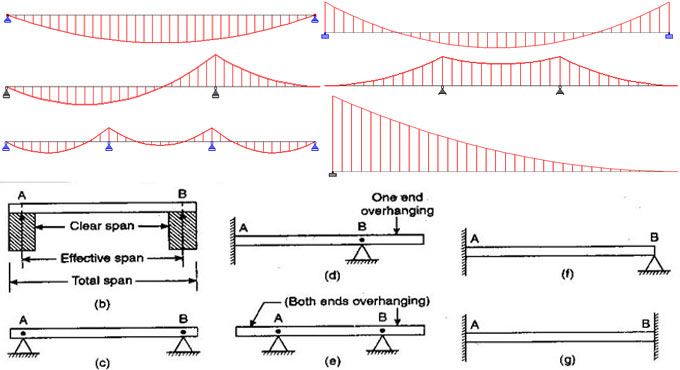
How beams are categorized on the basis of different factors

In structural engineering, various structural members are titled on the basis of their behavior under applied load. If the primary mode of delivering the load occurs due to bending then the structural member is known as beam. It can be also said that a beam belongs to a structural component that has the ability to resist load initially by making resistance against bending.
Beams usually bear vertical gravitational forces but can also be applied for bearing horizontal loads (e.g., loads originate because of an earthquake or wind). The loads which beam bear are transmitted to columns, walls, or girders and which then transfer the force to the adjoining structural members and lastly to the ground.
Categorization of Beam: Beams are distinguished with their support condition, profile (shape of cross-section),geometry, equilibrium condition, and their material.
Categorization on the basis of supports: Categorization of beams on the basis of support condition is essential since the bending moment functioning on the beam is directly influenced by the support condition. The difference can be seen in the bending moment diagrams given below. For the equivalent length and loading the bending moment diagram fluctuates significantly with change in support condition.
Simply supported ? Beams are supported on the ends which can rotate easily without any moment resistance.
Fixed ? Beams are supported on both ends and constrained from rotation.
Over hanging ? Simple beams which are expanded beyond its support on one end.
Double overhanging ? Simple beams with both ends extending beyond its supports on both ends.
Continuous ? Beams are expanded over in excess of two supports.
Cantilever ? A projecting beam that is fixed only at one end.
Trussed ? A beam is reinforced with the inclusion of a cable or rod to develop a truss.
Categorization on the basis of profile: The type and magnitude of internal stress created in the beam is directly reliant on the shape of the cross-section, thus categorization is necessary on the basis of profile.
Rectangular Beams: I-Beams, T-Beams, C-Beams, Other Cross-sections
Categorization on the basis of geometry: The type and magnitude of internal stress created in the beam is also directly reliant on the geometry of the beam, thus categorization is necessary on the basis of geometry.
Straight Beams, Curved Beams, Tapered Beams
Categorization based on indeterminacy: The design of beam is mainly created for bending moment and shear force. Assessment of these bending moments and shear force is called analysis. A beam is classified into following two categories on the basis of the type of analysis necessary to work out the reaction:
Statically determinate beams: equilibrium conditions tolerable to compute reactions.e.g. simply supported beams, cantilever beams, single and double overhanging beams etc.
Statically indeterminate beams: Deflections (Compatibility conditions) together with equilibrium equations should have been applied to determine the reactions.e.g. propped cantilever, continuous beams, fixed beams.
Categorization on the basis of the material: Various materials contain different advantages and drawbacks for being utilized as a building material for erecting the beams concerning cost and usage, as a result beams are also classified on the basis of the material used for their construction.
Concrete Beams, Steel Beams, Timber Beams


